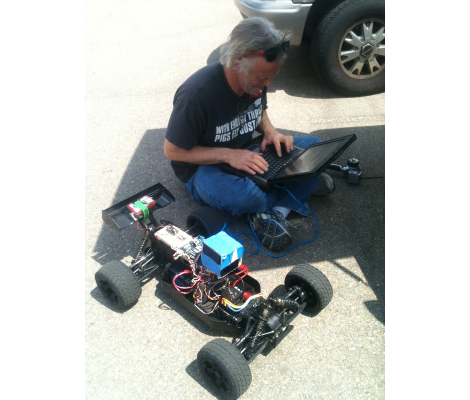
[Paul Breed] participated in this year’s Autonomous Vehicles Contest put on by SparkFun Electronics. As with most projects, the deadline really snuck up on him and he ended up cramming a bunch of code development into the waning days before the competition. His experiences are shared in this recent blog post.
One big part of the hardware is a laser range finder used for wall following. This is explained well in the video after the break, but you can see the side-pointing blue box in the image above. [Paul] also spent a lot of time preparing for the checkpoint portion of the course where the vehicle would need to pass through a red hoop. He worked long and hard on an image processing setup to find and navigate those hoops before learning that they would be positioned at known locations and it would be much easier to use a path following technique to complete the challenge.
He had a few follies along the way. At one point during debugging the car — which was connected to his laptop via Ethernet — it got away from him. This ripped the NIC right out of the back of his computer. And on the day of the event he had some low battery issues that zapped his laser calibrations. But [Paul] rolled with the punches and ended having what sounds like a really exciting experience participating in the contest.















“This ripped the NIC right out of the back of his computer.”
Epic fail, snap the tab off your Ethernet cable to make them quick release.
It should be noted that Paul Breed previously competed in the Northrup Grumman Lunar Lander challenge and held his own against John Carmack (Armadillo Aerospace, Id software guru) and the eventual winners, Masten Space. Not bad for a guy working out of his garage.
Check out photos from the Sparkfun 2013 AVC in Boulder Colorado http://www.23rdstudios.com/portfolio/sparkfun-autonomous-vehicle-competition-avc/
Nice work and thanks for putting together this article! We built a similar project. However, we installed an Android device onto a RC car and used an IOIO board instead to control it autonomously. Here is the preliminary result:
http://youtu.be/vkvkfcqEUkk